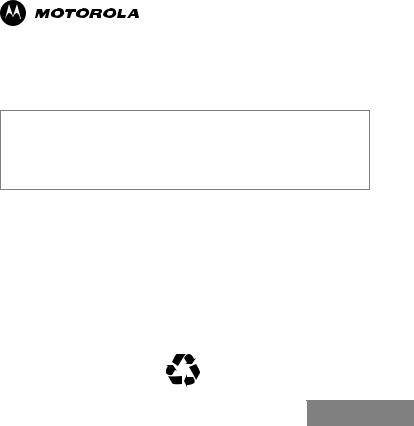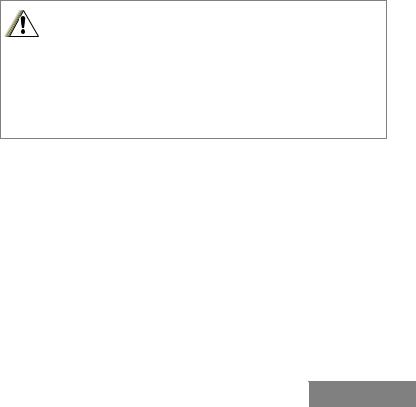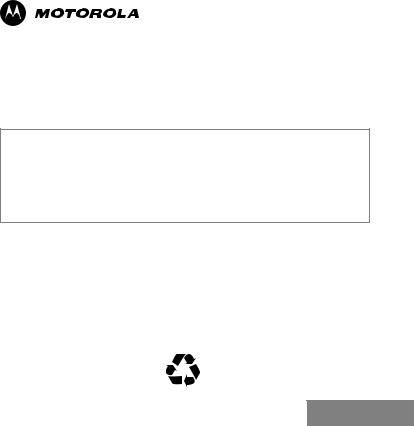Motorola 89FT5867, 89FT7066, 89FT7065, 89FT5866 Users Manual

RF ENERGY EXPOSURE AND PRODUCT SAFETY GUIDE FOR PORTABLE TWO-WAY RADIOS
ATTENTION! Before using this radio, read this guide which contains important operating instructions for safe usage and RF energy awareness and control for compliance with applicable standards and regulations.
MOTOROLA, MOTO, MOTOROLA SOLUTIONS and the Stylized M logo are trademarks or registered trademarks of Motorola Trademark Holdings, LLC and are used under license. All other trademarks are the property of their
respective owners.
© 2007 – 2013 Motorola Solutions, Inc. All rights reserved.
Motorola Solutions, Inc.
1303 E. Algonquin Rd., Schaumburg,
IL 60196, U.S.A.
*NNTN7223F*
NNTN7223F
6881095C98-J
English
RF Energy Exposure Awareness and Control Information and Operational Instructions for Occupational Use
NOTICE: This radio is intended for use in occupational/controlled conditions where users have full knowledge of their exposure and can exercise control over their exposure to meet the occupational limits in FCC and International standards. This radio device is NOT authorized for general population consumer use.
This two-way radio uses electromagnetic energy in the radio frequency (RF) spectrum to provide communications between two or more users over a distance. It uses radio frequency (RF) energy or radio waves to send and receive calls. RF energy is one form of electromagnetic energy. Other forms include, but are not limited to, sunlight and x-rays. RF energy, however, should not be confused with these other forms of electromagnetic energy, which when used improperly, can cause biological damage. Very high levels of x-rays, for example, can damage tissues and genetic material.
Experts in science, engineering, medicine, health, and industry work with organizations to develop standards for safe exposure to RF energy. These standards provide recommended levels of RF exposure for both workers and the general public. These recommended RF exposure levels include substantial margins of protection.
All Motorola two-way radios are designed, manufactured, and tested to ensure they meet government-established RF exposure levels. In addition, manufacturers also recommend specific operating instructions to users of two-way radios. These instructions are important because they inform users about RF energy exposure and provide simple procedures on how to control it.
English |
2 |
|
|
|
|

Please refer to the following websites for more information on what RF energy exposure is and how to control your exposure to assure compliance with established RF exposure limits:
http://www.fcc.gov/oet/rfsafety/rf-faqs.html www.who.int/en/ www.motorolasolutions.com/rfhealth
Federal Communication Commission (FCC) Regulations
When two-way radios are used as a consequence of employment, the FCC requires users to be fully aware of and able to control their exposure to meet occupational requirements. Exposure awareness can be facilitated by the use of a product label directing users to specific user awareness information. Your Motorola two-way radio has a RF Exposure Product Label. Also, your Motorola user manual, or separate safety booklet includes information and operating instructions required to control your RF exposure and to satisfy compliance requirements.
Compliance with RF Exposure Standards
Your Motorola two-way radio is designed and tested to comply with a number of national and International standards and guidelines (listed below) for human exposure to radio frequency electromagnetic energy. This radio complies with the IEEE (FCC) and ICNIRP exposure limits for occupational/controlled RF exposure environments at operating duty factors of up to 50% talk-50% listen and is approved for occupational use only. In terms of measuring RF energy for compliance with these exposure guidelines, your radio generates measurable RF energy only while it is transmitting (during talking), not when it is receiving (listening) or in standby mode.
3 |
English |
|
NOTE: The approved batteries, supplied with this radio, are rated for a 5-5-90 duty factor (5% talk-5% listen-90% standby) even though this radio complies with FCC occupational exposure limits and may operate at duty factors of up to 50% talk.
Your Motorola two-way radio complies with the following RF energy exposure standards and guidelines:
•United States Federal Communications Commission (FCC), Code of Federal Regulations; 47 CFR et seq. & FCC, OET Bulletin 65
•Institute of Electrical and Electronic Engineers (IEEE) C95.1
•International Commission on Non-Ionizing Radiation Protection (ICNIRP)
•Ministry of Health (Canada) Safety Code 6 & Industry Canada RSS-102
•Australian Communications Authority Radiocommunications Standard et seq.
•ANATEL ANNEX to Resolution No. 303 et seq.
RF Exposure Compliance and Control Guidelines and Operating Instructions for Two-Way Radio Operations
To control your exposure and ensure compliance with the occupational/controlled environment exposure limits, always adhere to the following procedures.
•DO NOT remove the RF Exposure Label from the device.
•User awareness instructions should accompany device when transferred to other users.
English |
4 |
|
|
|
|

Two-Way Radio Operation
•Transmit no more than the rated duty factor of 50% of the time. To transmit (talk), push the Push-To-Talk (PTT) button. To receive calls, release the PTT button. The PTT button may reside on the radio itself or may be hosted on approved wired or wireless (for example, a Bluetooth enabled remote Push-to-Talk button) accessories. Transmitting 50% of the time, or less, is important because this radio generates measurable RF energy exposure only when transmitting (in terms of measuring for standards compliance).
•In front of the face. Hold the radio in a vertical position with the microphone (and other parts of the radio including the antenna) at least one inch (2.5 centimeters) away from the nose or lips. Keeping the radio at a proper distance is important to ensure compliance.
NOTE: RF exposures decrease with increasing distance from the antenna.
•Body Worn Operation. When worn on the body, always place the radio in a Motorola-approved clip, holder, holster, case, or body harness for this product. Using approved body-worn accessories is important because the use of non- Motorola-approved accessories may result in exposure levels, which exceed the occupational/controlled environment RF exposure limits.
•Use only Motorola-approved supplied or replacement antennas, batteries, and audio accessories. Use of non-Motorola-approved antennas, batteries, and wired or wireless accessories may exceed the applicable RF exposure guidelines (iEEE, ICNIRP or FCC).
•For a list of Motorola-approved accessories for your radio model, visit the following website: http://www.motorolasolutions.com/governmentandenterprise
5 |
English |
|
Electromagnetic Interference/Compatibility
NOTE: Nearly every electronic device is susceptible to electromagnetic interference (EMI) if inadequately shielded, designed, or otherwise configured for electromagnetic compatibility.
Facilities
To avoid electromagnetic interference and/or compatibility conflicts, turn off your radio in any facility where posted notices instruct you to do so. Hospitals or health care facilities may be using equipment that is sensitive to external RF energy.
Aircraft
When instructed to do so, turn off your radio when on board an aircraft. Any use of a radio must be in accordance with applicable regulations per airline crew instructions.
Medical Devices
Pacemakers
The Advanced Medical Technology Association (AdvaMed) recommends that a minimum separation of 6 inches (15 centimeters) be maintained between a handheld wireless radio and a pacemaker. These recommendations are consistent with those of the U.S. Food and Drug Administration.
Persons with pacemakers should:
•ALWAYS keep the radio more than 6 inches (15 centimeters) from their pacemaker when the radio is turned ON.
•Not carry the radio in the breast pocket.
•Use the ear opposite the pacemaker to minimize the potential for interference.
•Turn the radio OFF immediately if there is any reason to suspect that interference is taking place.
English |
6 |
|
|
|
|

Hearing Aids
Some digital wireless radios may interfere with some hearing aids. In the event of such interference, you may want to consult your hearing aid manufacturer to discuss alternatives.
Other Medical Devices
If you use any other personal medical device, consult the manufacturer of your device to determine if it is adequately shielded from RF energy. Your physician may be able to assist you in obtaining this information.
Use of Communication Devices While Driving
Always check the laws and regulations on the use of radios in the areas where you drive.
•Give full attention to driving and to the road.
•Use hands-free operation, if available.
•Pull off the road and park before making or answering a call, if driving conditions or regulations so require.
7 |
English |
|

Acoustic Safety
Exposure to loud noises from any source for extended periods of time may temporarily or permanently affect your hearing. The louder the radio's volume, the less time is required before your hearing could be affected. Hearing damage from loud noise is sometimes undetectable at first and can have a cumulative effect.
To protect your hearing:
•Use the lowest volume necessary to do your job.
•Turn up the volume only if you are in noisy surroundings.
•Turn down the volume before adding headset or earpiece.
•Limit the amount of time you use headsets or earpieces at high volume.
•When using the radio without a headset or earpiece, do not place the radio's speaker directly against your ear.
Operational Warnings
For Vehicle With Air Bags:
Refer to vehicle manufacturer's manual prior to installation of
electronic equipment to avoid interference with air bag wiring.
W A R N I N G
DO NOT place a portable radio in the area over an air bag or in the air bag deployment area. Air bags inflate with great force. If a portable radio is placed in the air bag deployment area and the air bag inflates, the radio may be propelled with great force and cause serious injury to occupants of the vehicle.
English |
8 |
|
|
|
|

Operational Warnings (Continued)
Potentially Explosive Atmospheres
(Explosive atmospheres refers to hazard classified locations that
may contain hazardous gas, vapors, or dusts.)
W A R N I N G
Turn off your radio prior to entering any area with a potentially explosive atmosphere unless it is a portable radio type especially qualified for use in such areas as Intrinsically Safe (for example, Factory Mutual, CSA, UL, or CENELEC).
DO NOT remove, install, or charge batteries in such areas. Sparks in a potentially explosive atmosphere can cause an explosion or fire resulting in bodily injury or even death.
The areas with potentially explosive atmospheres referred to above include fueling areas such as below decks on boats, fuel or chemical transfer or storage facilities, and areas where the air contains chemicals or particles such as grain, dust or metal powders. Areas with potentially explosive atmospheres are often, but not always, posted.
Blasting Caps and Blasting Areas
To avoid possible interference with blasting operations, turn off your radio when you are near electrical blasting caps, in a blasting area, or in areas posted: "Turn off two-way radio." Obey all signs and instructions.
9 |
English |
|

Operational Cautions
|
Antennas |
|
DO NOT use any portable radio that has a damaged antenna. If a |
C a u t i o n |
damaged antenna comes into contact with your skin, a minor burn can |
result. |
Batteries
All batteries can cause property damage and/or bodily injury, such as burns, if a conductive material such as jewelry, keys, or beaded chains touches exposed terminals. The conductive material may complete an electrical circuit (short circuit) and become quite hot. Exercise care in handling any charged battery, particularly when placing it inside a pocket, purse, or other container with metal objects.
Intrinsically Safe Radio Information
The Intrinsically safe approval unit refers to a product that has been approved as intrinsically safe by an approval agency (for example FM Approvals, CSA, UL, or Cenelec) and certifies that a particular product meets the Agency's applicable intrinsic safety standards for specific types of hazardous classified locations. A portable radio that has been approved for intrinsic safety will have Approval label attached to the radio to identify the unit as being Approved for specified hazardous atmospheres. This label specifies the hazardous Class/Division/Group along with the part number of the battery that must be used. The Intrinsically Safe Approval Label will be located on the portable radio unit.
English |
10 |
|
|
|
|

Operational Cautions for Intrinsic Safe Equipment
•DO NOT operate radio communications equipment in a hazardous atmosphere unless it is a type especially qualified (for example, FM,
UL, CSA, or CENELEC approved). An explosion or fire may result.
C a u t i o n • DO NOT operate a radio unit that has been approved as intrinsically safe product in a hazardous atmosphere if it has been physically damaged (for example, cracked housing). An explosion or fire may result.
•DO NOT replace or charge batteries in a hazardous atmosphere. Contact sparking may occur while installing or removing batteries and cause an explosion or fire.
Warnings for Radios Approved as Intrinsically Safe
Radios must ship from the Motorola manufacturing facility with the hazardous atmosphere capability and the intrinsic safety approval labelling (FM, UL, CSA, CENELEC). Radios will not be upgraded to this capability and labeled once they have been shipped to the field.
A modification changes the unit’s hardware from its original design configuration. Modifications can only be made by the original product manufacturer.
11 |
English |
|

• DO NOT replace or change accessories in a hazardous atmosphere. Contact sparking may occur while installing or removing
accessories and cause an explosion or fire.
W A R N I N G • Turn the radio off before removing or installing a battery or accessory.
•DO NOT disassemble an intrinsically safe product in any way that exposes the internal circuits of the unit.
•Failure to use an intrinsically safe approved battery or Approved accessories specifically approved for the radio unit may result in the dangerously unsafe condition of an unapproved radio combination being used in a hazardous location.
•Unauthorized or incorrect modification of the intrinsically safe approved Product will negate the approval rating of the product.
•Incorrect repair or relabeling of any intrinsically safe Agencyapproved radio could adversely affect the Approval rating of the unit.
•Use of a radio that is not intrinsically safe in a hazardous atmosphere could result in serious injury or death.
Repair
REPAIRS FOR MOTOROLA PRODUCTS WITH INTRINSICALLY SAFE APPROVAL ARE THE RESPONSIBILITY OF THE USER.
Repairs to a Motorola FM approved radio product should only be W A R N I N G done at a location that has been FM audited under the FM 3605
repairs and service standard.
Contact Motorola for assistance regarding repairs and service of Motorola intrinsically safe equipment.
English |
12 |
|
|
|
|

A repair constitutes something done internally to the unit that would bring it back to its original condition.
Items not considered as repairs are those in which an action is performed on a unit which does not require the outer casing of the unit to be opened in a manner that exposes the internal electrical circuits of the unit.
Do Not Substitute Options or Accessories
The Motorola communications equipment certified as intrinsically safe by the approving agency, (FM, UL, CSA, CENELEC) is tested as a complete system which consists of the listed agency Approved portable, Approved battery, and Approved accessories or options, or both. This Approved portable and battery combination must be strictly observed. There must be no substitution of items, even if the substitute has been previously Approved with a different Motorola communications equipment unit. Approved configurations are listed by the Approving Agency (FM, UL, CSA, CENELEC).
The Intrinsically Safe Approval Label affixed to radio refers to the intrinsically safe classification of that radio product, and the approved batteries that can be used with that system.
The manual PN referenced on the Intrinsically Safe Approval Label identifies the approved Accessories and or options that can be used with that portable radio unit.
Using a non-Motorola-intrinsically-safe battery and or accessory with the Motorola approved radio unit will void the intrinsically safe approval of that radio unit.
13 |
English |
|
Notes:
English |
14 |
|
|
|
|

GUIA DE SEGURANÇA DO PRODUTO E EXPOSIÇÃO À ENERGIA DE RF PARA RÁDIOS PORTÁTEIS BIDIRECIONAIS
ATENÇÃO! Antes de usar o rádio, leia este guia que contém instruções operacionais importantes para uso seguro, informações sobre conscientização e controle de exposição à energia de radiofrequência (RF) para conformidade com os padrões e regulamentos aplicáveis.
MOTOROLA, MOTO, MOTOROLA SOLUTIONS e a letra "M" |
|
estilizada do logotipo são marcas comerciais ou marcas registradas |
|
da Motorola Trademark Holdings, LLC e são utilizadas sob licença. |
|
Todas as demais marcas registradas são de propriedade de seus |
*NNTN7223F* |
respectivos proprietários. |
|
© 2007 – 2013 Motorola Solutions, Inc. |
NNTN7223F |
Todos os direitos reservados. |
|
Motorola Solutions, Inc. |
6881095C98-J |
1303 E. Algonquin Rd., Schaumburg, |
|
IL 60196, E.U.A. |
|
Português do Brasil
Informações sobre Conscientização e Controle de Exposição à RF e Instruções Operacionais para Uso Ocupacional
COMUNICADO: este rádio destina-se ao uso em condições ocupacionais/ controladas, em que os usuários têm total conhecimento de sua exposição e possam exercer controle sobre sua exposição para atender aos limites ocupacionais definidos pela FCC e pelos padrões internacionais. O dispositivo de rádio NÃO é autorizado para uso pela população em geral.
Este rádio bidirecional usa energia eletromagnética no espectro de RF para fornecer comunicação à distância entre dois ou mais usuários. Ele usa energia de RF ou ondas de rádio para enviar e receber chamadas. A energia de RF é uma forma de energia eletromagnética. Outras formas incluem, mas não são limitadas a, raios, raios solares e raios X. A energia de RF, entretanto, não deve ser confundida com essas outras formas de energia eletromagnética, que quando são usadas incorretamente, podem causar danos biológicos. Níveis muito altos de raios X, por exemplo, podem danificar tecidos e material genético.
Especialistas em ciências, engenharia, medicina, saúde e indústrias trabalham com organizações para desenvolver padrões de exposição segura à energia de RF. Esses padrões fornecem níveis recomendados de exposição à RF para trabalhadores e para o público em geral. Os níveis recomendados de exposição à RF incluem margens de segurança substanciais.
Todos os rádios bidirecionais da Motorola são projetados, fabricados e testados para garantir que atendam aos níveis de exposição à RF estabelecidos pelo governo. Além disso, os fabricantes também recomendam instruções operacionais específicas para usuários de rádios bidirecionais. Essas instruções são importantes porque informam aos usuários sobre a exposição à energia de RF e fornecem procedimentos simples sobre como controlar essa exposição.
Português do Brasil |
16 |
|
|
|
|

Consulte os sites a seguir para obter mais informações sobre a exposição à energia de RF e como controlar a exposição para garantir conformidade com os limites de exposição à RF estabelecidos:
http://www.fcc.gov/oet/rfsafety/rf-faqs.html www.who.int/en/ www.motorolasolutions.com/rfhealth
Regulamentos da FCC
Ao usar rádios bidirecionais por motivos de trabalho, a FCC (Federal Communication Commission, comissão federal de comunicação) requer que os usuários estejam totalmente conscientes e aptos a controlar sua exposição de modo a atender às exigências ocupacionais. A conscientização da exposição pode ser facilitada pelo uso de uma etiqueta no produto, direcionando o usuário para informações de conscientização específicas do usuário. O rádio bidirecional da Motorola possui uma Etiqueta no Produto sobre Exposição à RF. Além disso, o manual do usuário da Motorola, ou folheto de segurança em separado, inclui informações e instruções operacionais necessárias para controlar a exposição à RF e atender aos requisitos de conformidade.
Conformidade com os Padrões de Exposição à RF
O rádio bidirecional da Motorola foi projetado e testado para estar em conformidade com vários padrões e com as diretrizes nacionais e internacionais (listados a seguir) para exposição de seres humanos à energia eletromagnética de radiofrequência.
Este rádio está em conformidade com os limites de exposição IEEE (Institute of Electrical and Electronic Engineers, instituto de engenheiros elétricos e eletrônicos) (FCC) e ICNIRP para ambientes ocupacionais/controlados de exposição à RF em fatores operacionais de trabalho de até 50% de fala e 50% de escuta e está aprovado apenas para uso ocupacional. Para medição de energia de RF para conformidade com essas diretrizes de exposição, o rádio gera energia de RF mensurável apenas quando está transmitindo (na fala), não quando está recebendo (escuta) ou no modo de espera.
17 |
Português do Brasil |
|
